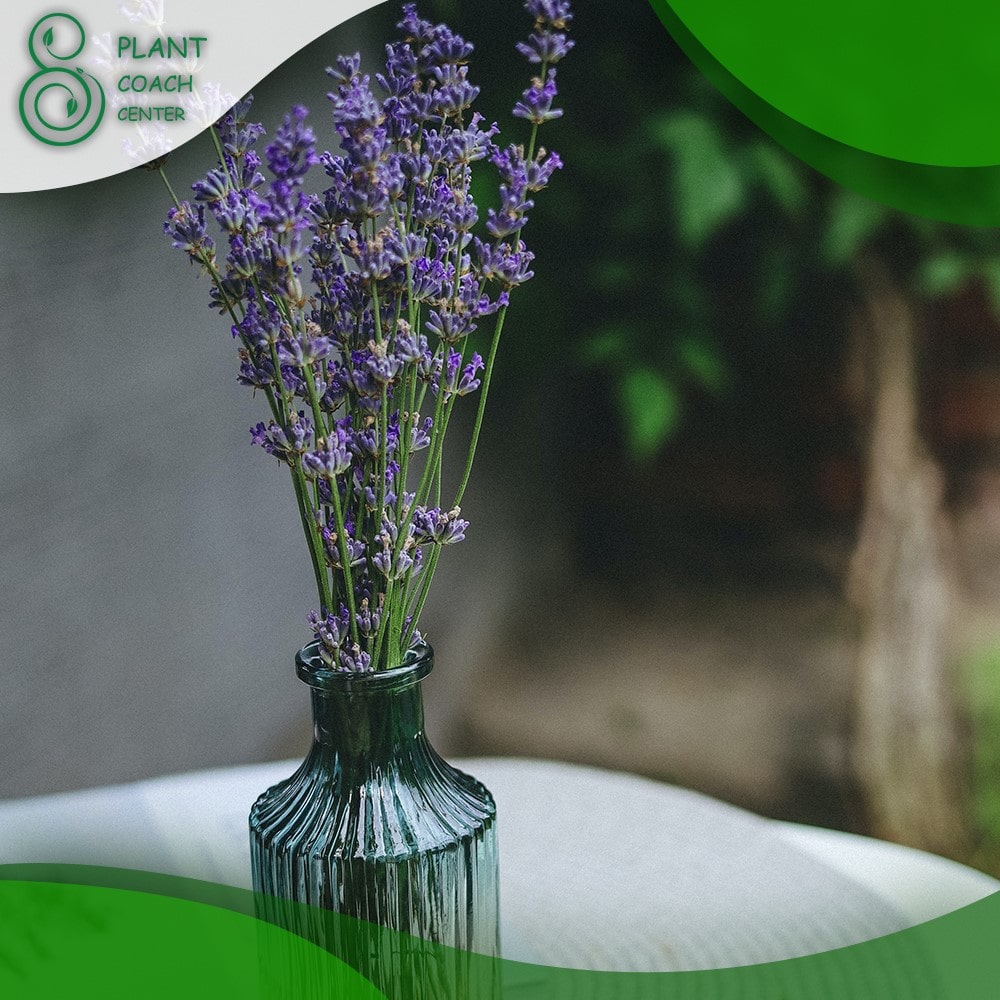When Should I Prune Lavender
Welcome to the fragrant world of lavender, where nature’s beauty and soothing aromas converge. As you bask in the calming presence of this beloved herb, you might find yourself pondering a vital question: When should I prune lavender? Much like a delicate dance with a cherished partner, the timing of lavender pruning plays a pivotal role in ensuring its health, longevity, and exuberant blossoming.
Imagine the joy of witnessing vibrant lavender fields or the allure of a freshly picked bouquet; these captivating scenes result from a well-timed pruning routine. In this horticultural journey, we will unravel the mysteries of lavender pruning, exploring the intricacies of each season’s nuances and the artistry behind each precise snip.
Whether you’re a seasoned gardener or a budding enthusiast, this article will guide you through the enchanting process of nurturing your lavender plant to reach its fullest potential. Join us as we delve into the rhythm of nature, learning the harmonious choreography of when and how to prune your lavender for a symphony of growth and beauty.
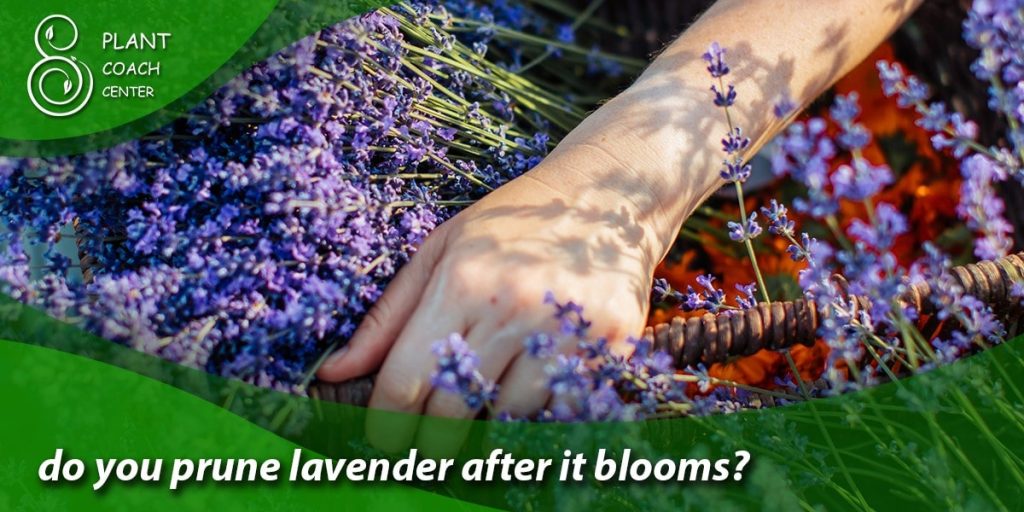
Timing for Lavender Love
Lavender, with its delicate purple blooms and enchanting fragrance, demands a touch of finesse when it comes to pruning. To master the art of pruning lavender, understanding the optimal timing is essential. The key lies in aligning your pruning schedule with the plant’s natural growth cycle. As spring awakens, resist the urge to grab your pruning shears too soon.
Allow your lavender to relish the first signs of life, letting new growth emerge from the woody stems. Once the initial burst of growth has subsided, typically in late spring or early summer, it’s time to prepare your pruning tools. Trimming your lavender at this juncture encourages a bushier and more compact growth habit, preventing the plant from becoming leggy or woody. Remember, patience is your ally in this endeavor, as waiting for the right moment ensures your lavender will flourish throughout the seasons.
As you contemplate the timing of lavender pruning, consider the characteristics of the specific lavender variety you’re tending to. English lavender (Lavandula angustifolia) and French lavender (Lavandula stoechas) have slightly different preferences regarding pruning times. While English lavender benefits from a gentle trim right after its first bloom, usually in early summer, French lavender thrives with a lighter pruning after each flowering cycle to encourage continuous blossoming.
The timing of lavender pruning is a delicate balance between allowing the plant to express its natural growth and giving it the guidance it needs to flourish. By tuning into the rhythm of the seasons and the unique attributes of your lavender variety, you can ensure that your pruning endeavors result in a breathtaking display of beauty and fragrance. So, mark your calendars and prepare to engage in a horticultural pas de deux with your lavender, nurturing it through timely trims for a spectacle of botanical elegance.
Seasonal Signals
Nature has an intricate way of communicating, and understanding its cues can significantly impact the success of your lavender pruning efforts. When it comes to pruning lavender, paying attention to the changing seasons provides valuable insights into when your plant is ready for a trim. As winter’s grip begins to loosen and the frosty days give way to the promise of spring, keep an eye out for the emergence of new growth on your lavender. This is the plant’s signaling that it’s awakening from its dormant state and is ready to embark on a new growth cycle.
As the days grow longer and warmer and your lavender unfurls its first delicate blooms, resist the temptation to prune immediately. Allow your lavender to revel in its newfound vitality, and let the flowers paint a vibrant canvas. During this initial bloom, the plant directs its energy towards producing those alluring blossoms. After this initial show of color, usually in late spring to early summer, you’ll notice a lull in flowering. This is the prime moment to wield your pruning shears.
By tuning into these seasonal signals, you can ensure that your lavender receives the pruning it needs at the perfect time. This thoughtful approach not only enhances the aesthetics of your plant but also contributes to its overall health and vigor. Remember, your lavender is a partner in this botanical journey, whispering its needs through the language of seasons. Embrace this natural dialogue and embark on a journey of growth and beauty guided by the rhythmic dance of the Earth’s cycles.
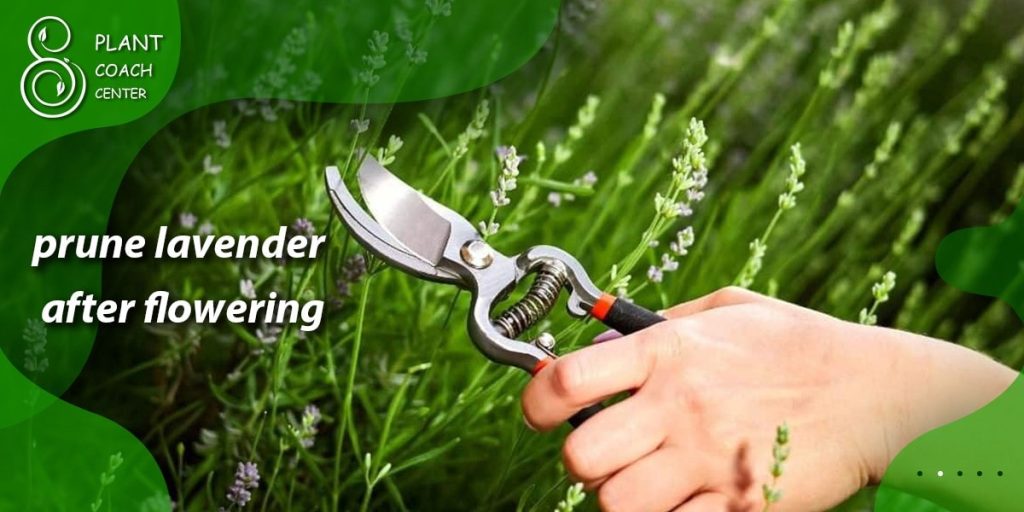
Post-Bloom Perfection
The grand finale of lavender’s performance is undoubtedly its breathtaking bloom, a visual and aromatic spectacle that captures the season’s essence. As the final petals fall and the sweet fragrance begins to wane, it’s time to turn your attention to the next act: post-bloom pruning. This phase, occurring in the late summer or early fall, is a pivotal moment in maintaining the health and vitality of your lavender plant.
Post-bloom pruning serves multiple purposes, each contributing to the overall well-being of your lavender. Begin by removing spent flower stalks, a task that cleans up the plant’s appearance and prevents the formation of seeds. This redirects the plant’s energy away from seed production and towards root growth, ensuring a solid foundation for future seasons.
Beyond the aesthetic benefits, post-bloom pruning allows air circulation and sunlight penetration, minimizing the risk of fungal diseases that can plague dense lavender growth. Trim back any straggly or overgrown branches to maintain the plant’s compact and pleasing shape, and ensure that lower foliage receives adequate sunlight by removing any excessive growth around the base.
The post-bloom period also offers light overall pruning, focusing on removing a portion of the new growth without cutting into the older woody stems. This delicate balance preserves the plant’s structure while encouraging fresh change for the following year’s bloom. As you engage in this post-bloom grooming ritual, envision it as a way to honor the magnificence of the past while nurturing the potential of the future.
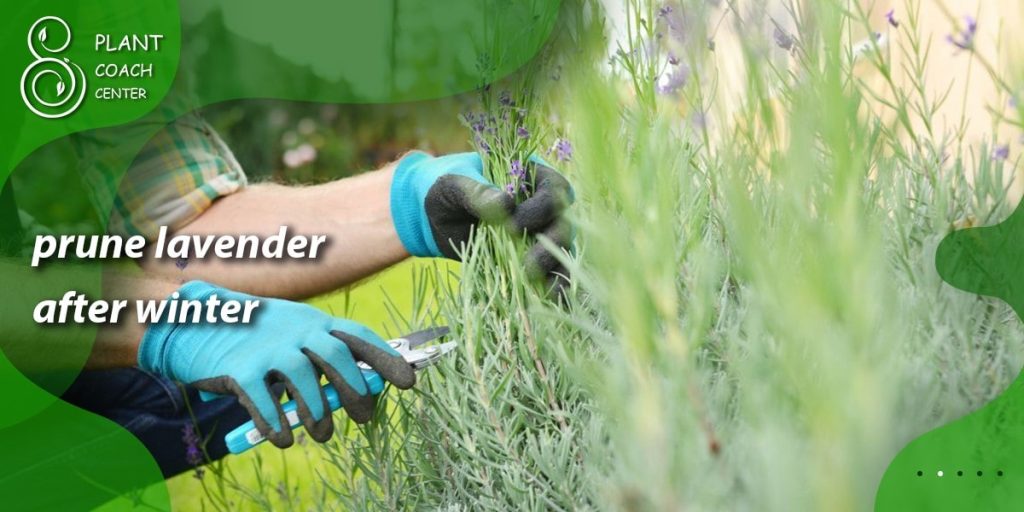
Post-Bloom Perfection
As the curtain closes on the vibrant bloom of your lavender, a new phase of care emerges—post-bloom perfection. Just as an artist refines their masterpiece, you, too, can fine-tune your lavender plant after its stunning floral display. This stage typically arrives in the late summer or early fall, promising continued vitality and beauty.
Commencing this phase involves a series of careful steps to ensure your lavender remains healthy and poised for its next splendid act. Begin by removing the faded flower spikes, tidying the appearance, and preventing the diversion of energy into seed production. Redirecting this energy towards the roots strengthens the plant’s foundation, setting the stage for future growth.
Post-bloom perfection isn’t solely about aesthetics; it’s also a pivotal strategy to stave off potential issues. Trimming back any excessive growth or straggly branches encourages improved air circulation and sunlight exposure. This preemptive measure guards against the development of fungal diseases that can plague dense lavender foliage.
Consider this phase as a gentle touch-up rather than a dramatic overhaul. While a light overall pruning can be beneficial, avoid cutting into the older woody stems. Instead, focus on trimming a portion of the newer growth. This approach preserves the plant’s shape while nurturing fresh shoots for the upcoming season.
Post-bloom perfection is your lavender’s spa day—an opportunity to rejuvenate and prepare for the seasons ahead. By engaging in this practice, you’re sustaining the allure of your lavender and fostering a relationship of care and growth. So, as the blooms gracefully fade, remember that this isn’t the end of the story; it’s a segue into the next chapter of your lavender’s journey, a chapter where meticulous pruning paves the way for its continued splendor.
Winter Wisdom
In the quiet embrace of winter, as frost paints a delicate pattern across the landscape, your lavender retreats into a period of dormancy. Yet, even in its slumber, your plant requires a touch of care and attention to ensure its vitality when spring arrives. Although more restrained than other seasons, winter pruning holds a unique wisdom that safeguards your lavender through the cold months.
Unlike the more robust pruning of other seasons, winter pruning for lavender is a gentle affair. As the year ends and your plant enters its restorative phase, consider a light tidying-up. Remove any dead or diseased branches, allowing the plant to conserve energy for the awaited revival.
Another aspect of winter wisdom is to avoid excessive pruning during this season. The woody stems of lavender can be sensitive to severe cuts when temperatures are low. By erring on caution, you prevent potential damage to the plant’s structure, setting the stage for a healthy spring awakening.
Winter also provides the ideal opportunity to reassess your lavender’s surroundings. Check for proper drainage and protection from harsh winter winds, ensuring your plant remains cozy and sheltered.
Winter pruning imparts a subtle yet profound lesson in patience and preservation. By delicately attending to your lavender during this quiet season, you’re safeguarding its well-being and cultivating a deep understanding of the plant’s needs. As winter blankets the earth, remember that beneath the frost, your lavender is preparing for its triumphant return, and your thoughtful winter care plays a vital role in its eventual reawakening.
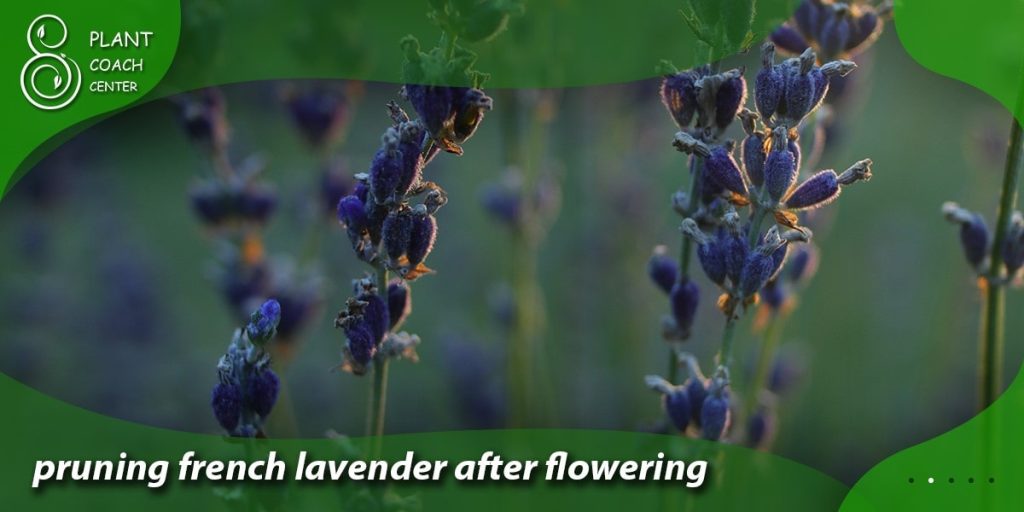
Spring Awakening
As the world awakens from its winter slumber, your lavender joins the symphony of rebirth, eagerly pushing out new growth and hinting at the beauty it holds within. Spring, a season of renewal and rejuvenation, is the perfect time to engage in one of the most transformative acts of care for your lavender: spring pruning.
With the emergence of new shoots and the promise of forthcoming blooms, spring pruning presents an opportunity to shape your lavender’s growth trajectory. As the danger of frost subsides and the days grow longer, examine your plant closely. Look for new growth along the woody stems, indicating the plant is ready to embrace the new season.
Spring pruning focuses on two main objectives: first, to stimulate the growth of fresh shoots that will bear blooms, and second, to maintain the plant’s overall shape and vitality. To achieve this, trim away approximately one-third of the new growth, cutting just above a pair of healthy leaves. This method encourages branching and avoids cutting into the older wood, which can hinder further growth.
In the world of lavender, timing is everything. Prune too early, and you risk cutting off potential growth; prune too late, and you might compromise the plant’s overall health. Aim for a sweet spot in the early spring, just as the first flush of growth appears, but before the plant invests too much energy into these new shoots.
Summer Shaping
As the sun stretches its warm embrace over the landscape and summer’s abundance surrounds you, your lavender takes center stage with its vibrant blooms and intoxicating fragrance. This is the season of growth and fullness, and your role as a caretaker shifts towards maintaining the exuberance that summer brings. Welcome to the realm of summer shaping, a practice that harmonizes with the season’s energy.
While summer is not the primary season for lavender pruning, it still offers a chance to engage in light shaping to keep your plant looking its best. As your lavender flourishes and bursts into a colorful display, some branches may extend beyond the intended shape. Gently trim back these stragglers to maintain the desired compact and bushy form.
Summer shaping isn’t just about aesthetics; it’s also about preserving your plant’s health. Removing spent flower spikes—those that have finished blooming—prevents the plant from channeling energy into seed production, redirecting it towards producing new growth. This practice contributes to a prolonged blooming period, allowing you to savor the sight and scent of lavender for an extended time.
As you approach summer shaping, remember the gentle touch this season demands. Unlike the more vigorous pruning of spring or post-bloom phases, your summer trimming is about finesse rather than transformation. Pay attention to the plant’s natural form, enhancing it without sacrificing its shape and structure.
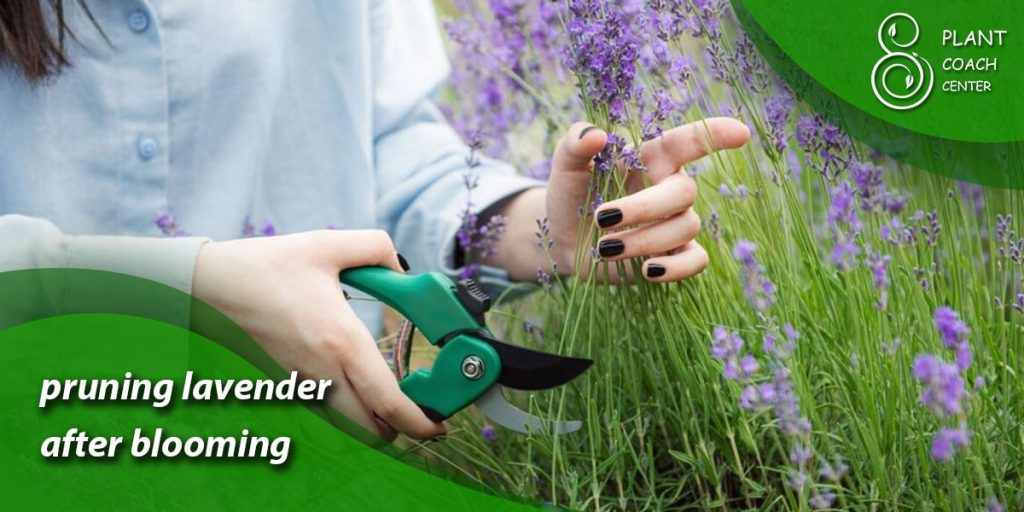
Fall Farewell
As the days begin to shorten and a crispness enters the air, your lavender prepares for its graceful exit from the spotlight. Fall is a season of transition, a time when your plant readies itself for the restorative slumber of winter. Fall farewell pruning is your way of gently guiding your lavender towards a season of rest while ensuring its robust return in the following year.
In the golden embrace of autumn, your lavender has likely completed its primary blooming cycle, and the blooms are gradually fading away. This is the opportunity to engage in a mindful pruning routine that encourages the plant’s longevity and resilience. Begin by removing any spent flower stalks, tidying up the appearance, and preventing the formation of seeds.
Fall farewell pruning also involves carefully assessing your lavender’s overall structure. Trim back any unruly branches or growth that extends beyond the desired shape. This practice is critical as it helps to ensure proper air circulation and sunlight exposure, minimizing the risk of fungal diseases that can develop in the denser growth of the plant.
As you perform fall farewell pruning, remember that this isn’t a dramatic trim; it’s a gentle act of care that sets the stage for your lavender’s winter slumber. Avoid heavy pruning that might compromise the plant’s structure and instead focus on maintaining its shape and encouraging healthy growth for the upcoming year.
Conclusion
In the intricate dance of nurturing lavender, pruning emerges as a symphony of care, each season a movement that contributes to the plant’s enduring vitality and beauty. From the delicate timing of spring’s awakening to the gentle shaping of summer and the thoughtful preparation for winter’s rest, each phase carries its own wisdom and purpose.
As you embark on your journey with lavender, remember that pruning is not merely a task but a dialogue with nature—a way of nurturing growth while respecting the plant’s inherent rhythm. Whether you are an experienced gardener or a novice with a budding passion, PlantCouchCenter.com is your companion on this captivating journey.
Explore its resources, immerse yourself in the wealth of knowledge, and allow your love for lavender to flourish alongside the vibrant blooms you tend. With each well-timed snip and every tender touch, you’re not just caring for a plant but engaging in a transformative partnership with the essence of life’s cycles.
When is the best time to prune lavender?
Prune in late spring or after the first bloom to maintain shape and encourage growth.
Can I prune lavender in summer?
Yes, lightly shape lavender during summer to control growth and maintain appearance.
Is fall pruning suitable for lavender?
Yes, fall farewell pruning tidies the plant and readies it for winter dormancy.


